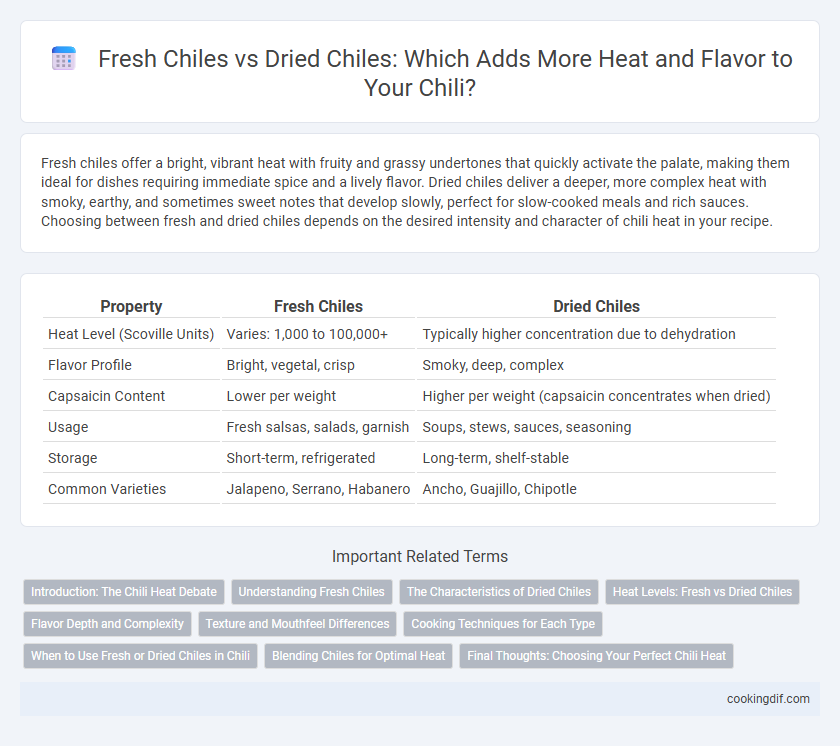Fresh chiles offer a bright, vibrant heat with fruity and grassy undertones that quickly activate the palate, making them ideal for dishes requiring immediate spice and a lively flavor. Dried chiles deliver a deeper, more complex heat with smoky, earthy, and sometimes sweet notes that develop slowly, perfect for slow-cooked meals and rich sauces. Choosing between fresh and dried chiles depends on the desired intensity and character of chili heat in your recipe.
Table of Comparison
| Property | Fresh Chiles | Dried Chiles |
|---|---|---|
| Heat Level (Scoville Units) | Varies: 1,000 to 100,000+ | Typically higher concentration due to dehydration |
| Flavor Profile | Bright, vegetal, crisp | Smoky, deep, complex |
| Capsaicin Content | Lower per weight | Higher per weight (capsaicin concentrates when dried) |
| Usage | Fresh salsas, salads, garnish | Soups, stews, sauces, seasoning |
| Storage | Short-term, refrigerated | Long-term, shelf-stable |
| Common Varieties | Jalapeno, Serrano, Habanero | Ancho, Guajillo, Chipotle |
Introduction: The Chili Heat Debate
Fresh chiles deliver vibrant, sharp heat with higher water content and bright fruity flavors, ideal for immediate use in salsas and sauces. Dried chiles offer concentrated heat and deeper smoky, earthy undertones, enhancing complex flavor profiles in slow-cooked dishes. The choice between fresh and dried chiles significantly impacts the chili's heat intensity and aromatic depth in culinary applications.
Understanding Fresh Chiles
Fresh chiles offer a vibrant, bright heat with fruity and grassy undertones that enhance the complexity of dishes. Their water content delivers immediate heat intensity that diminishes quickly, unlike dried chiles which provide a deeper, smokier, and longer-lasting heat profile. Understanding the distinct flavor and heat characteristics of fresh chiles is crucial for balancing chili recipes and achieving desired spiciness levels.
The Characteristics of Dried Chiles
Dried chiles offer a concentrated heat and deeper, smoky flavor compared to fresh chiles, making them a staple in traditional chili recipes. Their low moisture content intensifies the capsaicin, resulting in a more potent and lasting heat profile. Varieties like ancho, guajillo, and chipotle provide unique aromatic notes that enhance the complexity of chili dishes.
Heat Levels: Fresh vs Dried Chiles
Fresh chiles often deliver a sharper, more immediate heat due to their higher water content and the presence of capsaicin primarily in the membrane and seeds. Dried chiles concentrate capsaicin, resulting in a deeper, sometimes smokier heat that can linger longer on the palate. The Scoville Heat Units (SHU) of dried chiles can be significantly higher than their fresh counterparts, making them a preferred choice for intense, complex chili heat in cooking.
Flavor Depth and Complexity
Fresh chiles offer bright, sharp heat with crisp, vegetal notes that enhance the immediate spiciness of dishes, while dried chiles provide deeper, more complex flavors with smoky, earthy, and sometimes fruity undertones that develop through the drying process. The capsaicin concentration in dried chiles is often higher, delivering a more concentrated and lingering heat compared to the fresher, more volatile capsaicin in fresh chiles. Using both fresh and dried chiles in cooking balances the heat intensity and enriches flavor complexity, creating a multi-dimensional chili heat profile.
Texture and Mouthfeel Differences
Fresh chiles offer a crisp, juicy texture that delivers an immediate, sharp heat intensity, enlivening dishes with vibrant flavor bursts. Dried chiles provide a deeper, smoky complexity and a chewier, sometimes slightly gritty mouthfeel, which intensifies as it rehydrates during cooking. The choice between fresh and dried chiles significantly influences the chili's heat profile and the overall sensory experience of texture and flavor.
Cooking Techniques for Each Type
Fresh chiles provide a vibrant, crisp heat ideal for quick sauteing or roasting, enhancing dishes with bright, fruity flavors and a sharp spiciness. Dried chiles, often rehydrated or ground, offer deeper, smoky, and more complex heat profiles suited for slow simmering, stewing, or blending into sauces like mole. Understanding the distinct cooking techniques--quick-cooking methods for fresh chiles and prolonged cooking for dried--maximizes their unique heat contributions and flavor complexities in chili recipes.
When to Use Fresh or Dried Chiles in Chili
Fresh chiles provide bright, vibrant heat ideal for dishes needing a crisp, lively flavor and shorter cooking times, such as salsas or quick stews. Dried chiles offer a deeper, smokier heat profile perfect for slow-cooked chili recipes, enhancing richness and complexity over extended simmering periods. Choosing fresh or dried chiles depends on the desired flavor intensity and cooking duration of your chili dish.
Blending Chiles for Optimal Heat
Blending fresh chiles and dried chiles creates a complex heat profile by combining the bright, sharp heat of fresh varieties with the deep, smoky intensity of dried ones. Fresh chiles like jalapenos add vibrant, immediate heat, while dried chiles such as ancho or chipotle contribute layered, lingering spice and rich flavor. Balancing both types enhances chili heat complexity, ensuring optimal spiciness and aromatic depth in dishes.
Final Thoughts: Choosing Your Perfect Chili Heat
Fresh chiles provide vibrant, bright heat with complex fruity undertones, ideal for dishes needing immediate spice and fresh flavor. Dried chiles offer deeper, smokier heat and concentrated flavor, perfect for slow-cooked recipes and rich sauces. Selecting between fresh and dried chiles depends on desired heat intensity, flavor profile, and cooking method, ensuring the perfect chili heat for every culinary creation.
Fresh Chiles vs Dried Chiles for chili heat Infographic

 cookingdif.com
cookingdif.com